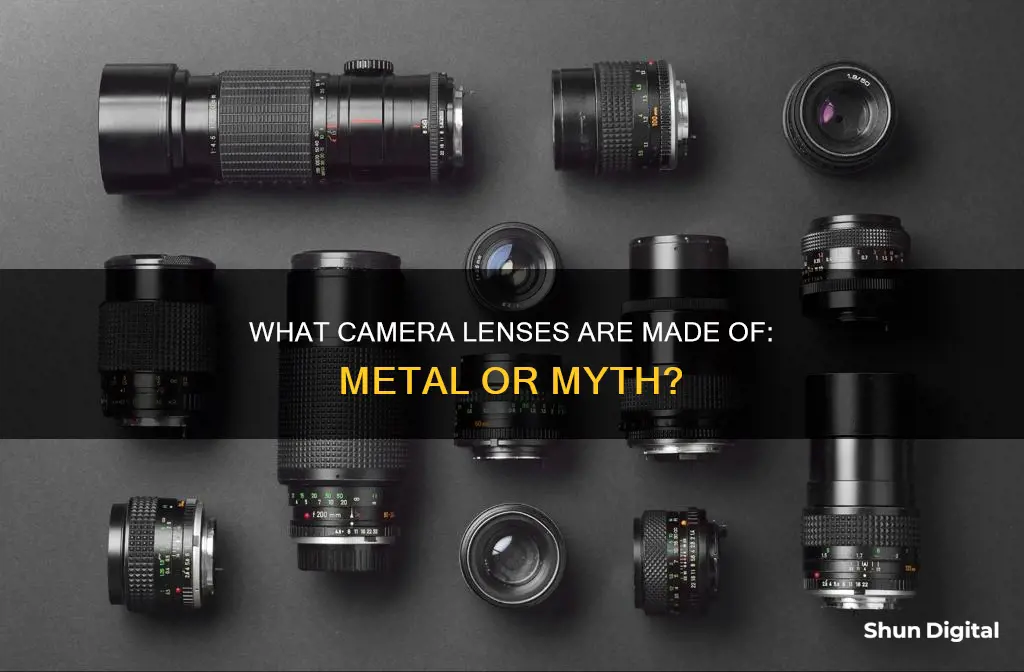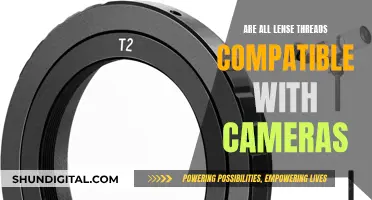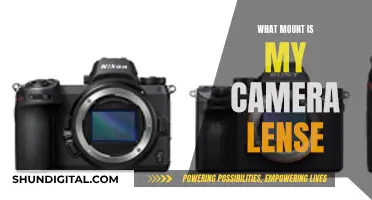
Camera lenses are complex optical devices that rely on a variety of materials to capture images. While glass is the primary component of a lens, playing a crucial role in bending and focusing light, other materials like metal and plastic also contribute to the lens's structure and function.
The lens barrel, which houses the glass elements and holds them in place, can be made of metal, high-quality plastic, or a combination of both. Metal lens barrels are commonly found in professional-grade lenses, valued for their durability and longevity. On the other hand, high-quality plastics are used in lighter and more affordable lenses, offering structural integrity without compromising image quality.
In addition to the lens barrel, metal also plays a role in other lens components. The aperture, which controls the amount of light entering the lens, is constructed using a series of overlapping metal blades. These blades create a variable opening, allowing for precise control over light intake and enabling creative effects like bokeh.
While the presence of metal in camera lenses is essential, it is just one part of the intricate combination of materials and technologies that come together to create these remarkable optical tools.
| Characteristics | Values |
|---|---|
| Lens Barrel Material | Metal or High-Quality Plastic |
| Metal Lens Barrel Use Case | Professional-Grade Lenses |
| Metal Mounts | More Durable |
| Plastic Mounts | Budget-Friendly, Reduces Weight |
What You'll Learn

Metal lens mounts are more durable than plastic mounts
Metal lens mounts are generally better at withstanding wear and tear than plastic ones. This is especially true for higher-end lenses that are heavier due to an increased number of glass elements and sturdier components. A strong lens mount is crucial as it bears the weight of the lens and camera, preventing potential damage.
Metal is also more likely to last longer, break less often, and be recycled if needed. Vintage cameras and lenses, known for their durability, were often made of metal. While plastic may be more lightweight and cost-effective, metal provides the advantage of added strength and resilience.
It is worth noting that some photographers prefer metal mounts for peace of mind, especially when using heavy lenses. Metal mounts inspire confidence in the user, assuring them that their equipment can withstand the demands of various shooting conditions and environments.
Additionally, metal lens mounts are desirable when it comes to repairability. When a plastic mount breaks, it tends to be an obvious, complete break. In contrast, metal mounts are less likely to break and often require adjustments to bent or shifted internal components, which can take several hours for optical alignment.
While plastic mounts have their advantages, metal lens mounts are indeed more durable. Metal mounts can withstand heavier weights, are less prone to breaking, and offer a sense of reliability that is valuable to photographers, especially in challenging situations.
The Myth of Circular Camera Lenses: Fact or Fiction?
You may want to see also

Metal camera mounts are usually made of metal
Metal camera mounts provide better support for heavier lenses. A heavy lens coupled with a plastic mount may lead to potential damage in the mount area. The lens mount is an essential component in the DSLR camera, as it is the only part that holds the camera body and lens together. Therefore, it is crucial to ensure that the mount is sturdy enough to support the weight of the lens and camera.
In addition to durability, metal camera mounts offer peace of mind to users. Knowing that their lens is coupled with a metal mount gives users confidence in the durability of their equipment, especially when using heavy lenses. Metal mounts are also less likely to break than plastic ones, and in the event that they do, they can be easily replaced.
It is worth noting that plastic mounts have their advantages too. They help reduce the overall weight of the lens, making it more comfortable for users during extended periods of use. Plastic mounts can also help reduce costs, making high-quality lenses more accessible to consumers.
Overall, while metal camera mounts are generally the norm, plastic mounts have their place in the market and offer their own set of benefits. The choice between metal and plastic mounts depends on various factors, including the weight of the lens, the intended use, and the user's budget.
Camera Lenses for DSLRs: Are They Piratical and Affordable?
You may want to see also

Metal lenses are more likely to last longer than plastic lenses
The Canon AE-1, which was released after the Canon AE-1, marked the camera industry's shift towards plastic lenses that felt like metal. This shift occurred because plastic lenses are lighter and less prone to breaking due to their flexible material. However, despite this shift, metal lenses are still preferred by many photographers.
Metal lenses are less likely to break than plastic lenses. If a metal lens takes a dent, the plastic lens is more likely to crack and need replacement. Additionally, metal lenses are also more scratch-resistant than plastic lenses, which further contributes to their longevity.
Furthermore, metal lenses are also found to be clearer than plastic lenses. Glass, which is typically housed by metal, provides the clearest vision with minimal distortion. This is especially important for photographers who require sharp and clear images.
While metal lenses offer durability and longevity, they also have some drawbacks. Metal lenses are heavier than plastic lenses, which can cause discomfort during extended use. Additionally, the weight of metal lenses limits their compatibility with certain frame styles, such as semi-rimless and rimless frames. They are also more delicate than plastic lenses and can crack or shatter upon impact.
In conclusion, metal lenses offer robustness, longevity, and clarity. These factors contribute to their durability and make them more likely to last longer than plastic lenses. However, metal lenses also have some disadvantages, such as increased weight and delicacy. Ultimately, the choice between metal and plastic lenses depends on the specific needs and preferences of the photographer.
Camera Lenses: Do They Have an Expiry Date?
You may want to see also

Metal lenses are more expensive than plastic lenses
Metal lenses are more durable than plastic lenses. Metal mounts are generally able to withstand wear and tear better than their plastic counterparts. This is especially true for higher-end lenses that are heavier due to an increased number of glass elements and/or heavier, sturdier components used in their construction. Plastic mounts, on the other hand, are usually found on kit/budget lenses to keep costs down.
Metal lenses are also heavier than plastic lenses. The weight of the lens can become uncomfortable, especially if you plan to wear it all day. The heaviness can also cause the lens to frequently slide down your face, which can become irritating over time. The weight of the glass lens also makes it incompatible with semi-rimless and rimless frames.
Metal lenses are also more difficult to tint. Since metal is a hard, non-absorbent material, applying a tint is difficult and generally not recommended. Plastic lenses, on the other hand, are compatible with a large variety of frames that come in different shapes, sizes, thicknesses, and colours.
While metal lenses offer durability and longevity, plastic lenses offer several advantages as well. Plastic lenses are lightweight, durable, reduce glare, and are easy to tint. Ultimately, the choice between metal and plastic lenses depends on the specific needs and preferences of the photographer.
Camera Lenses: Sales, Deals, and Discounts
You may want to see also

Metal lenses are heavier than plastic lenses
Heavier lenses can cause pressure points on the nose, which can be uncomfortable and unattractive. They may also cause the glasses to slide down the wearer's face, which can be irritating over time. This is why plastic lenses have become the most popular choice in recent years. They are much lighter and more comfortable to wear, and their light weight helps them stay in place for longer.
However, metal lenses do have some advantages over plastic. Metal lens barrels, typically found in professional-grade lenses, offer robustness and longevity. Metal lenses are also more likely to last longer, be recycled if broken, and less likely to break than plastic lenses.
In addition, the choice between metal and plastic lenses may depend on individual factors such as visual acuity and personal taste. For example, natural glass lenses are recommended for bifocal or trifocal lenses because various materials can be melted together without forming a noticeable cutting edge. They also have better scratch resistance than plastic lenses.
Overall, while metal lenses are heavier than plastic lenses, both types have their own advantages and disadvantages, and the choice between the two will depend on the specific needs and preferences of the wearer.
RF Lenses: The Future of Mirrorless Photography?
You may want to see also
Frequently asked questions
Yes, camera lenses have metal. While the core of a camera lens is made of glass, the lens barrel, which houses the glass elements, is often made of metal or high-quality plastic.
Metal provides durability and structural support to the delicate lens components. Metal lens barrels are typically found in professional-grade lenses and offer robustness and longevity.
Metal mounts are generally able to withstand wear and tear better than plastic. Metal is also less likely to break compared to plastic, which can crack more easily. Additionally, metal does not rust or corrode as easily as plastic.
No, not all camera lenses have metal. Plastic is also commonly used, particularly in kit or budget lenses, to keep costs down. Plastic lenses are lighter and can help reduce stress on the user during extended periods of use, such as while travelling or covering an event.







